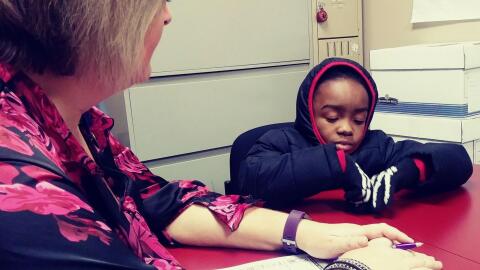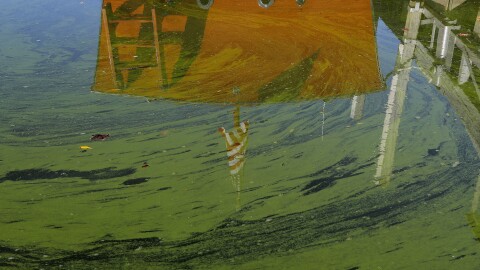Out on farmland in western New York, near the shore of Lake Erie, is Five & 20 Spirits And Brewing. Here, they make more than just booze 鈥� they also raise fish.
Inside a large white structure, set back behind the brewery, is a land-based aquaculture system. It鈥檚 the life鈥檚 work of Jere Northrop, founder of TimberFish Technologies.
As he walks inside, the sound of water bubbling in concrete tanks bounces off the curved walls and ceiling. Stillage 鈥� a byproduct of brewing 鈥� flows from a pipe into a steel bin, the color and texture of watery, chunky peanut butter.
"You can see it鈥檚 pretty gooky looking stuff, but it鈥檚 actually a tremendous food source if you鈥檙e a microbe, so it鈥檚 a good thing," Northrop says.
And it鈥檚 the first step in a food chain.
Air flows throughout the system, allowing microbes to break down and eat the stillage. The microbes are fed to invertebrates like earth worms, snails and insect larva, and then fish get to feast on them.
The goal is to raise several types of fish and sell them commercially.
"So instead of discharging the waste stream into the environment where it can cause water pollution and odor and all those kinds of things we turn that into a saleable product," Northrop says.
He says the technology, backed by a state grant, has a larger purpose.
"This is back to how we resolve the major environmental problems, which are due to the rising population and increasing pollution of the environment," Northrup says. "And, the way to do that is to generate an eco-technology which generates an economic incentive to do the right thing environmentally."

It also makes financial sense for the brewery, cutting waste disposal costs by thousands every year.
Mario Mazza, the brewery鈥檚 general manager, says adding the fish farm helps take the family business one step further.
"We feel it鈥檚 a good way to give back to the community and to do something that鈥檚 responsible," he says. "It鈥檚 a fun project it鈥檚 just cool to watch it come together from what was just a concept on paper a few years ago."
Aquaculture facilities typically are set up in oceans or lakes. The concept of a land-based system 鈥� raising fish in tanks -- is slowly catching on.
It could be a good fit for the Great Lakes region, says Kevin Madley, regional aquaculture coordinator for NOAA Fisheries, a federal agency.
"The Great Lakes themselves, the states have so far used a cautionary approach to putting aquaculture fish pens in the great lakes, they feel like there鈥檚 a chance for environmental harm and therefore they鈥檙e being very cautious and doing background research," he says.

The brewery has the capacity to produce about 20 thousand pounds of fish every year. They鈥檙e raising three different species: speckled trout, Arctic char and Atlantic salmon.
Northrop expects the fish to make tasty meal.
"The fish have an excellent nutrient composition, so they have a natural taste and color, because they鈥檙e eating their natural foods. They鈥檙e not eating pellet foods," he says. "We control all of the inputs so since there鈥檚 no toxic elements in the inputs, they鈥檙e won鈥檛 be toxic elements in the fish."
The fish will be plate-ready in the summer of 2019.
-8






